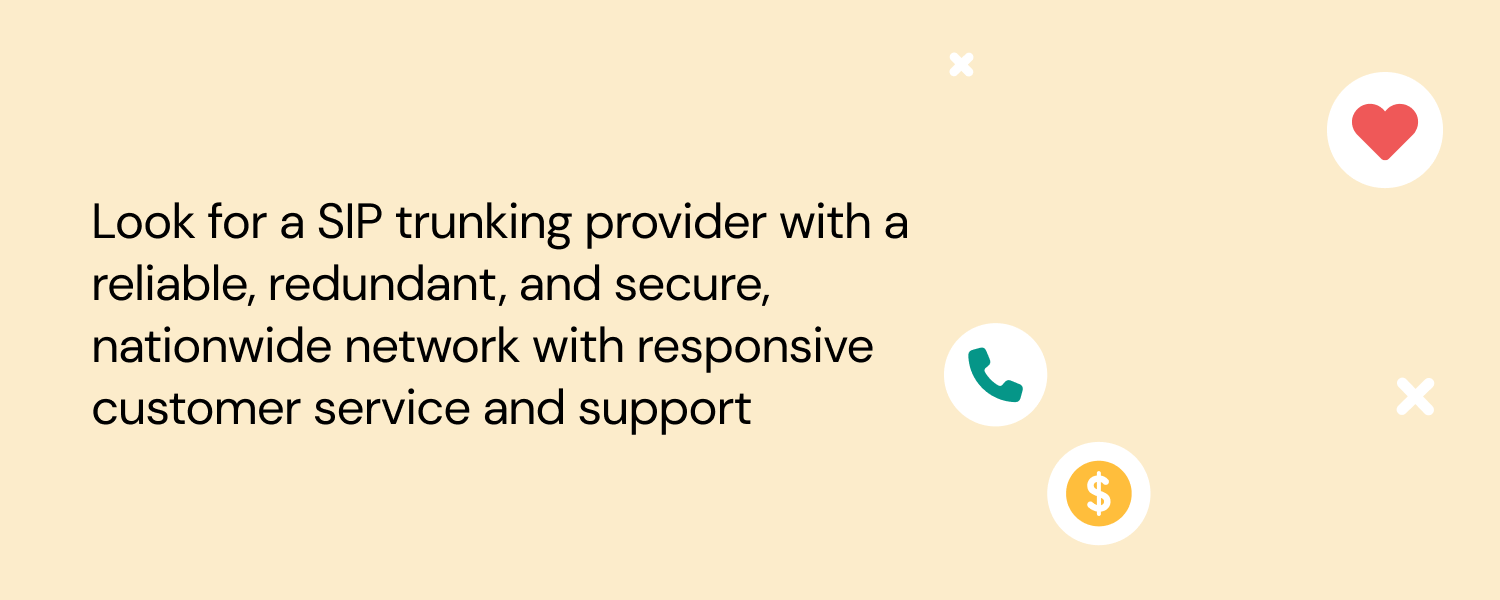SIP trunking has exploded in recent years, quickly becoming the mainstream service for IP-based communications.
And while Session Initiation Protocol (SIP) isn’t new — having been around for 20 years already — SIP trunks have become the replacement for Primary Rate Interface (PRI) trunks for PBXs.
Today, the SIP trunk market continues to rapidly grow. According to Transparency Market Research, it’s projected to reach $35.5 billion by 2030, growing at a 13% compound annual growth rate.
So, what makes SIP trunking a sensible choice for businesses today? And what options are available to organizations?
SIP trunking basics
SIP trunking services are provided by a communications service provider who uses the SIP protocol over an IP network to connect a PBX to the PSTN.
The SIP protocol is used to set up, manage, and tear down a call. Multiple calls can connect over the network simultaneously, providing a great deal of scalability to customers. Plus, the SIP protocol works with SIP signaling — a series of communications between SIP devices sending messages back and forth using SIP response codes in a SIP session.
Here's how this would work for a simple outbound call:
-
An employee dials the number on their analog phone.
-
The call is first routed through the business's on-premises phone system via PBX.
-
The PBX transmits the call to a SIP trunk, typically maintained by an Internet Telephony Service Provider (ITSP).
-
The SIP trunk opens a VoIP session with the number, then terminates the session when either participant disconnects.
Why choose SIP trunking?
Most businesses have moved to SIP trunking as the standard trunking service for their PBX. It’s more cost effective and flexible than traditional PRIs.
While traditional PRIs had a set number of channels available — typically 23 — SIP trunking enables companies to purchase any number of trunks based on their needs. This means companies no longer pay for channels they won’t use, offering a greater degree of control and flexibility over how calls are routed through a PBX system.
Benefits of SIP trunking
There’s no denying SIP trunking has a lot to offer businesses. Here are just a few key benefits:
-
Scalability: SIP trunks are easily scalable over an IP connection providing the customer with a cost-effective solution.
-
Flexibility: SIP trunks are very flexible. Customers can easily add SIP trunks to new locations as needed.
-
Feature-rich: SIP trunks can provide additional useful features carried out in the service provider network, including SIP Refer (call transfer), SIP REC (media forking for recording), and call forwarding.
-
Security: Customers may require additional levels of security to protect privacy. SIP trunking leverages TLS/SRTP encryption and supports dedicated access facilities using 1 gig or 10 gig circuits to connect customer networks to the service provider.
-
Portal: The service provider should have an easy-to-use portal allowing customers to manage their SIP trunks, numbers, emergency services, and toll-free service.
-
Cost savings: SIP trunks are more cost-effective than PRI. Different SIP trunk pricing models are available from service providers, including pay-as-you-go and session-based pricing.
-
Reliability: SIP trunks are inherently reliable. It’s recommended to increase reliability by having multiple connections to a service provider network. For example, a service provider may have network “on ramps” in multiple cities, allowing customers to have redundant access to the service provider network.
SIP trunking options
SIP trunking supports many services including Bring Your Own Carrier (BYOC) for popular communications and contact center solutions. These cloud-based services allow a customer to use a service provider of their choice.
-
SIP trunks for PBX: SIP trunks are used by PBXs to connect to the PSTN. Since SIP is a standard, SIP trunks are compatible with almost all PBXs.
-
Microsoft Teams direct routing: Microsoft Teams allows a broad range of partners to provide connectivity to the PSTN with BYOC. Direct routing requires a certified session border controller (SBC).
-
Microsoft Teams Operator Connect: Operator Connect is Microsoft’s newest version of BYOC provided by an exclusive group of Microsoft-approved partners. It’s easier to configure than direct routing and doesn’t require an SBC.
-
Cloud Connect for Webex Calling: Cloud Connect for Webex Calling is Cisco’s version of BYOC.
-
Unified Communications as a Service (UCaaS): A service utilizing SIP as the protocol for calling.
-
Programmable voice: Programmable voice allows a business to make, receive, control, and monitor calls via software embedded in an application to allow the application to make and receive calls via SIP.

What to look for in a SIP trunking provider
There are many SIP trunking providers on the market. Here are key questions you should ask to help you find the right partner.
Network
-
Ownership: Does the provider have their own network? Private networks ensure better quality control, faster time to recovery, and better overall service.
-
Reliability: Does the provider proactively monitor their network around the clock, taking the necessary steps to ensure network diversity and uptime?
-
Redundancy: If a network failure occurs, is the provider capable of seamlessly rerouting calls? What measures has the provider implemented with regards to business continuity?
-
Network footprint: Does the provider offer coverage where your organization requires service? If not, do they have a means of facilitating coverage?
-
Security: What measures does the service provider have in place to protect against disruptive hacking attacks, including denial of service attacks (DDOS)? Has a provider experienced any of these attacks in the last two years?
-
Analytics: Does the service provider provide network analytics on how the network is performing?
-
Porting: How easy is it to port numbers to a service provider? Do they have the skillset and resources to help a customer manage large-scale ports?
-
Portal: Does the service provider have an intuitive portal allowing customers to easily manage their service?
Customer service and support
-
Project management: Does the service provider assign a dedicated project manager for large projects?
-
Cost for technical support: Does the service provider charge for technical support or do they offer assistance to help with technical, service-related issues?
-
Response time: How quickly does the provider address new support tickets?
-
Point of contact: Is there a single agent responsible for managing your account, or do you speak to a different professional each time?
-
Service-level agreement (SLA): Does the provider offer service-level agreements?
Choose the right SIP trunking provider for your organization
It’s important to select a service provider who can best meet your current and future needs while offering a broad range of service options if your technology requirements change.
Sinch can help! With one of the largest owned-and-operated facilities-based footprints, we've been ranked as one of the largest SIP trunking providers in North America four years in a row.
See how easy it is to scale and meet your capacity requirements with a secure, geo-redundant network which delivers over 300 billion minutes of use annually.



